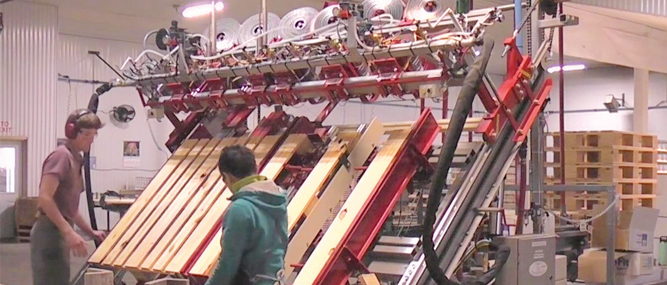Problem: Pallet Company Seeks Low-Cost Way to Produce Block Pallets
Solution: Stutzman Designs Woodpecker Two-Part Pallet Nailing System
Stutzman Manufacturing has developed a block pallet assembly system based on the company’s successful Woodpecker Junior nailing machine. Like other Stutzman machines, it uses pneumatic nailing tools and collated fasteners to assemble pallets. Nailing is done automatically by a moving nailing gantry. Any brand of pneumatic nailing tools can be used on the machine.
The new machine was developed specifically for a customer in the Midwest, but Ohio-based Stutzman is offering it as part of its portfolio of pallet assembly machines.
The company’s customer requested a lower priced, simple machine that could nail custom block pallets and would not require several workers to operate.
“That particular pallet is kind of unique,” noted Del Wagner of Midwest Machinery & Automation in Indiana, which represents Stutzman. The footprint is a standard 40×48 block pallet. However, some of the blocks are slightly smaller, and the top mat is oriented parallel to the stringers instead of perpendicular. The machine can be adjusted to assemble pallets as small as 30×30 and as large as 50×50, said Wagner.
The new Woodpecker Junior block pallet nailing system is designed to be operated by two workers who can produce one pallet per minute.
The system actually is two machines that can be set up adjacent to each other. One machine is a standard Woodpecker Junior mat machine that can automatically nail and assemble mats.
The second, new machine consists of two jigs side-by-side and one nailing gantry that automatically nails components in both jigs. On the right side is a jig to assemble the three block stringers for the pallet; on the left side is a jig to nail the mat to the stringers.
The jigs for both machines are angled to make it easier for the workers to load them with pallet parts.
With two workers, one operating each machine and working together on the block pallet nailing machine, a completed pallet can be assembled in a minute, according to Wagner. One worker uses the machine to assemble the top mat, and the other worker assembles the block stringers. After the machine nails the block stringers and a finished pallet next to it, the pallet is automatically ejected to the stacker. The workers move the assembled stringers into place on the other side of the machine, move the top mat into place, and put new blocks and deck boards into the right side of the machine to nail together new stringers.
The new machine is based on the standard Woodpecker Junior machine for assembling stringer pallets.
The Woodpecker machine for assembling mats is also popular with companies that build crates and boxes, noted Wanger, and it also can be used for assembling other wood products, such as gates. For crates, the machine is used to pre-assemble crate sides and panels that will be used as a side panel or top or bottom panel of a container.
Mats also can be assembled by hand on a jig that Stutsman manufactures, noted Wagner, so it is not necessary to buy two machines at one time. A company could add the second machine later to assemble mats.
“Stutsman will customize any of their machines,” said Wagner, to accommodate companies that assemble odd-size or specialty pallets.
A video of the new machine as well as videos of other Stutsman-made machines are available on the Midwest Machinery & Automation website (www.Woodpeckermachine.com).
For more information, call or email Del at 217-621-2133 or Del@woodpeckermachine.com.




